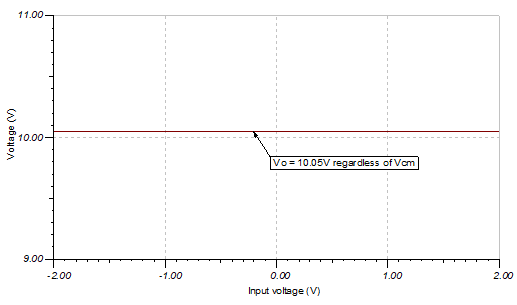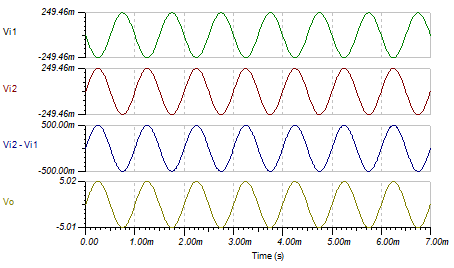-
Three Op Amp Instrumentation Amplifier Circuit
Three Op Amp Instrumentation Amplifier Circuit
Design Goals
| Input Vidiff (Vi2 – Vi1) | Common-Mode Voltage | Output | Supply | ||||
|---|---|---|---|---|---|---|---|
| Vi diff Min | Vi diff Max | Vcm | VoMin | VoMax | Vcc | Vee | Vref |
| -0.5 V | +0.5 V | ±7 V | –5 V | +5 V | +15 V | –15 V | 0 V |
Design Description
This design uses 3 op amps to build a discrete instrumentation amplifier. The circuit converts a differential signal to a single-ended output signal. Linear operation of an instrumentation amplifier depends upon linear operation of its building block: op amps. An op amp operates linearly when the input and output signals are within the device’s input common-mode and output swing ranges, respectively. The supply voltages used to power the op amps define these ranges.

Design Notes
- Use precision resistors to achieve high DC CMRR performance
- R10 sets the gain of the circuit.
- Add an isolation resistor to the output stage to drive large capacitive loads.
- High-value resistors can degrade the phase margin of the circuit and introduce additional noise in the circuit.
- Linear operation is contingent upon the input common-mode and the output swing ranges of the discrete op amps used. The linear output swing ranges are specified under the Aol test conditions in the op amps data sheets.
Design Steps
- Transfer function of this circuit:

When Vref = 0, the transfer function simplifies to the following equation:

where

- Select the feedback loop resistors
R5 and R6:

- Select R1, R2, R3, R4. To
set the Vref gain at 1 V/V and avoid degrading the instrumentation amplifier's CMRR,
ratios of R4/R3 and R2/R1 must be equal.

- Calculate R10 to meet the
desired gain:




- To check the common-mode voltage range, download and install the program from reference [5]. Edit the INA_Data.txt file in the installation directory by adding the code for a 3 op amp INA whose internal amplifiers have the common-mode range, output swing, and supply voltage range as defined by the amplifier of choice (TLV172, in this case). There is no Vbe shift in this design and the gain of the output stage difference amplifeir is 1 V/V. The default supply voltage and reference voltages are ±15 V and 0 V, respectively. Run the program and set the gain and reference voltage accordingly. The resulting VCM vs. VOUT plot approximates the linear operating region of the discrete INA.
Design Simulations
DC Simulation Results

Transient Simulation Results

References:
- Analog Engineer's Circuit Cookbooks
- SPICE Simulation File SBOMAU8
- TI Precision Labs
- Instrumentation Amplifier VCM vs. VOUT Plots
- Common-mode Range Calculator for Instrumentation Amplifiers
Design Featured Op Amp
| TLV171 | |
|---|---|
| Vss | 4.5 V to 36 V |
| VinCM | (V–) – 0.1 V < Vin < (V+) – 2 V |
| Vout | Rail–to–rail |
| Vos | 0.25 mV |
| Iq | 475 µA |
| Ib | 8 pA |
| UGBW | 3 MHz |
| SR | 1.5 V/µs |
| #Channels | 1,2, and4 |
| TLV171 | |
Design Alternate Op Amp
IMPORTANT NOTICE AND DISCLAIMER
| TI PROVIDES TECHNICAL AND RELIABILITY DATA (INCLUDING DATASHEETS), DESIGN RESOURCES (INCLUDING REFERENCE DESIGNS), APPLICATION OR OTHER DESIGN ADVICE, WEB TOOLS, SAFETY INFORMATION, AND OTHER RESOURCES “AS IS” AND WITH ALL FAULTS, AND DISCLAIMS ALL WARRANTIES, EXPRESS AND IMPLIED, INCLUDING WITHOUT LIMITATION ANY IMPLIED WARRANTIES OF MERCHANTABILITY, FITNESS FOR A PARTICULAR PURPOSE OR NON-INFRINGEMENT OF THIRD PARTY INTELLECTUAL PROPERTY RIGHTS. |
| These resources are intended for skilled developers designing with TI products. You are solely responsible for (1) selecting the appropriate TI products for your application, (2) designing, validating and testing your application, and (3) ensuring your application meets applicable standards, and any other safety, security, or other requirements. These resources are subject to change without notice. TI grants you permission to use these resources only for development of an application that uses the TI products described in the resource. Other reproduction and display of these resources is prohibited. No license is granted to any other TI intellectual property right or to any third party intellectual property right. TI disclaims responsibility for, and you will fully indemnify TI and its representatives against, any claims, damages, costs, losses, and liabilities arising out of your use of these resources. |
| TI’s products are provided subject to TI’s Terms of Sale (www.ti.com/legal/termsofsale.html) or other applicable terms available either on ti.com or provided in conjunction with such TI products. TI’s provision of these resources does not expand or otherwise alter TI’s applicable warranties or warranty disclaimers for TI products. |
| Mailing Address: Texas Instruments, Post Office Box 655303, Dallas, Texas 75265
Copyright © 2021, Texas Instruments Incorporated |